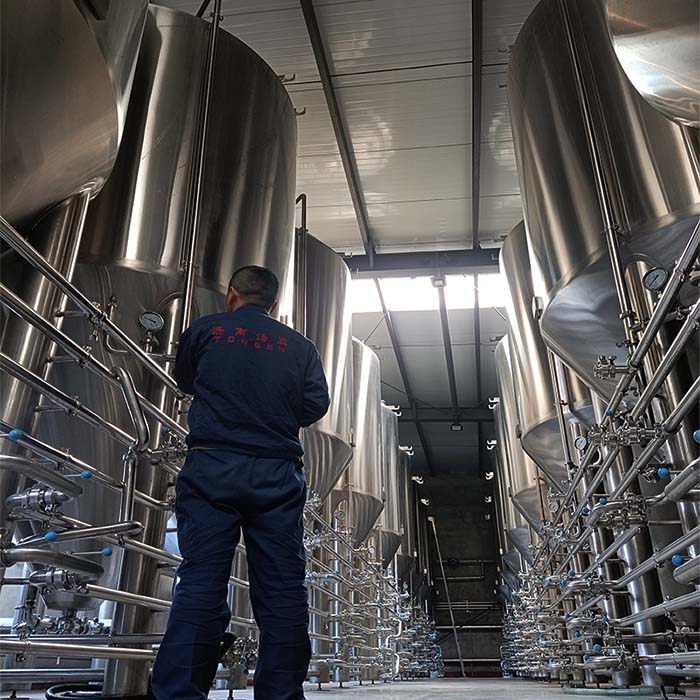RELATED
 How Profitable Is a Small Brewery? A Practical Guide for Aspiring Brewers2025-06-30
How Profitable Is a Small Brewery? A Practical Guide for Aspiring Brewers2025-06-30 Is brewing beer an expensive hobby? A comprehensive analysis of cost, value and return on investment2025-06-25
Is brewing beer an expensive hobby? A comprehensive analysis of cost, value and return on investment2025-06-25 How much does brewing equipment cost? —— Comprehensive analysis of cost, configuration and purchasing suggestions2025-06-21
How much does brewing equipment cost? —— Comprehensive analysis of cost, configuration and purchasing suggestions2025-06-21
MESSAGE
Planning Your Brewery: How to Estimate Space Needs for Tanks, Fermenters, and More
The Challenge of Space Estimation in Brewery Planning
Starting a brewery is an exciting venture, but one of the most daunting challenges is accurately estimating the space needed for your equipment. Whether you're setting up a microbrewery or a larger production facility, the layout and space allocation can make or break your operation. Many aspiring brewers underestimate the importance of proper space estimation, leading to cramped working conditions, inefficient workflows, and even safety hazards.
The core of the problem lies in understanding the spatial requirements for essential brewery equipment like tanks, fermenters, and other machinery. Without a clear plan, you might find yourself with insufficient space to expand or, worse, with equipment that doesn't fit your facility. This can result in costly modifications or delays in your production schedule.
The Consequences of Poor Space Planning
Imagine this: You've invested heavily in state-of-the-art brewing equipment, only to realize that your fermenters don't fit through the door or that your tanks are too close together for safe operation. These are not just hypothetical scenarios; they are real issues that many brewers face when they neglect proper space estimation.
Poor space planning can lead to a host of problems:
Inefficient Workflow: Cramped spaces can slow down your brewing process, making it difficult for staff to move around and perform tasks efficiently.
Safety Risks: Overcrowded equipment can pose safety hazards, increasing the risk of accidents and injuries.
Limited Expansion: Without adequate space, you may find it challenging to scale your operations as your business grows.
Increased Costs: Last-minute modifications to accommodate equipment can be expensive and time-consuming.
These issues can significantly impact your brewery's productivity, safety, and profitability. Therefore, it's crucial to get your space estimation right from the start.
A Step-by-Step Guide to Estimating Space Needs for Your Brewery
1. Assess Your Production Goals
Before you start measuring your space, you need to have a clear understanding of your production goals. How much beer do you plan to produce annually? What types of beer will you be brewing? Your production volume and variety will directly influence the size and number of tanks, fermenters, and other equipment you'll need.
2. List Essential Brewery Equipment
Make a comprehensive list of all the equipment you'll need, including:
Brewing Tanks: These are used for mashing, boiling, and whirlpooling.
Fermenters: Essential for the fermentation process.
Bright Tanks: Used for conditioning and carbonating beer.
Storage Tanks: For holding finished beer before packaging.
Packaging Equipment: Such as bottling or canning lines.
Utilities: Including chillers, boilers, and water treatment systems.
3. Determine Equipment Dimensions
Once you have your list, gather the dimensions of each piece of equipment. Manufacturers typically provide detailed specifications, including height, width, depth, and weight. Don't forget to account for additional space needed for maintenance and cleaning.
4. Calculate Floor Space Requirements
Using the dimensions, calculate the floor space required for each piece of equipment. Remember to include space for:
Access Pathways: Ensure there's enough room for staff to move around safely.
Utility Connections: Space for plumbing, electrical connections, and ventilation.
Future Expansion: Leave some extra space for additional equipment as your brewery grows.
5. Consider Vertical Space
Don't just focus on floor space; vertical space is equally important. Tall equipment like fermenters and storage tanks may require high ceilings. Ensure your facility can accommodate the height of your equipment, including any necessary clearance for installation and maintenance.
6. Create a Layout Plan
With all the measurements in hand, create a detailed layout plan. Use design software or even a simple sketch to visualize the arrangement of your equipment. This will help you identify any potential issues before you start setting up your brewery.
7. Consult with Experts
If you're unsure about any aspect of space estimation, don't hesitate to consult with experts. Experienced brewery planners or equipment suppliers can provide valuable insights and help you avoid common pitfalls.
8. Review and Adjust
Finally, review your plan thoroughly and make any necessary adjustments. It's much easier to make changes on paper than to rearrange heavy equipment later.
Conclusion: The Importance of Accurate Space Estimation in Brewery Planning
Accurate space estimation is a critical component of successful brewery planning. By taking the time to assess your production goals, list essential equipment, and calculate spatial requirements, you can avoid the common pitfalls of poor space planning. A well-thought-out layout will not only enhance your brewery's efficiency and safety but also provide room for future growth.
Remember, the key to a successful brewery lies in meticulous planning. By following this step-by-step guide, you'll be well on your way to creating a brewery that's both functional and scalable. Cheers to your brewing success!

https://www.tcbrewbeer.com/en/50hl-industry-brewery-equipment/
MESSAGE



